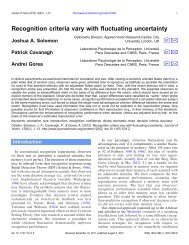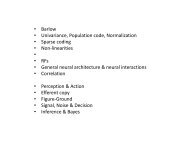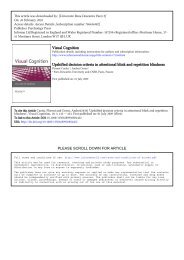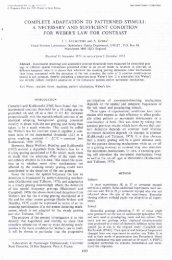Signal Detection Theory and Psychophysics - Andrei Gorea
Signal Detection Theory and Psychophysics - Andrei Gorea
Signal Detection Theory and Psychophysics - Andrei Gorea
You also want an ePaper? Increase the reach of your titles
YUMPU automatically turns print PDFs into web optimized ePapers that Google loves.
THEORIE DE LA DETECTION DU SIGNALLa Théorie de la Détection du <strong>Signal</strong> (TDS) est à la fois un instrument demesure de la performance* et un cadre théorique dans lequel cetteperformance est interprétée du point de vue des mécanismes sous-jacents.En tant que telle, la TDS peut être regardée comme étant à la base de lapsychophysique moderne. Le cours développera les bases de la TDS,discutera sa relation avec les concepts de seuil sensoriel et de décision etexemplifiera son application dans des situations expérimentales allantdepuis le sensoriel jusqu'au cognitif.*<strong>Signal</strong> <strong>Detection</strong> <strong>Theory</strong> is a computational framework that describes how to extract a signal from noise, whileaccounting for biases <strong>and</strong> other factors that can influence the extraction process. It has been usedeffectively to describe how the brain overcomes noise from both the environment <strong>and</strong> its own internal processes toperceive sensory signals (from Gold &Watanabe (2010). Perceptual learning. Current Biol., 20(2) R46-R48.
SIGNAL DETECTION THEORY AND PSYCHOPHYSICSDavid M. Green & John A. Swets1 st published in 1966 by Wiley & Sons, Inc., New YorkReprint with corrections in 1974Copyright © 1966 by Wiley & Sons, Inc.Revision Copyright © 1988 by D.M. Green & J. A. Swets1988 reprint edition published by Peninsula Publishing, Los Altos, CA 94023, USA
PhysicalWorldSensoryProcessesInference&DecisionProcessesResponseBehavior
PROBABABILITÉRÉPONSESIGNAL DETECTION THEORYTHE STANDARD MODELp(N)Rp(S)p(‘yes’│N) = p(R N >c)STIMULUSCRBruit <strong>Signal</strong>Misss 1HitsOui FA HitFAcNon CR Omiss.0SENSORY CONTINUUMS Rd' z(Hits) z(FA)B sc .5 z(H) z(FA) ; c - z FA Rp(‘yes’│S) = p(R S >c)
z-ScoreOu « score normal » ou « score st<strong>and</strong>ard »zxsZ scores-4.0 -3.0 -2.0 -1.0 0 +1.0 +2.0 +3.0 +4.0
f R : PROBABABILITÉSIGNAL DETECTION THEORYTHE STANDARD MODELThe likelihood ratioLe rapport de vraisemblanceHitsL(X)ppRRccSNffRRSNcc FAcSENSORY CONTINUUMR
P(z)p N (z=c)SIGNAL DETECTION THEORYTHE STANDARD MODEL0,5d’=1p(S) = . 50 = 1c = 00,40,3cp(S) = .25 ppSNzzc = 1.10ccppNS 30,20,1Nc 0c Ap S (z=c)Sc A = c + d’/2 = 1.60 = -zFA0-4 -3 -2 -1 0 1 2 3 4 5 6cSensory Continuum (z)
PROBABABILITYSDT: THE STANDARD MODELCriterion: the border between seen <strong>and</strong> not-seenp(N)sFAc’CONTINUUM SENSORIELRc'z FAc’ in s units!
Criterion settingObservers set a criterion that attempts to minimize the total errorrate (pMiss + pFA).xFor equally probable <strong>Signal</strong> <strong>and</strong> Noise, choose S <strong>and</strong> not N whenp(x|S) > p(x|N)i.e. when the likelihood ratio = p(x|S) / p(x|N) > 1For unequal probabilities of S <strong>and</strong> N, p(S) <strong>and</strong> p(N), optimal p(N) / p(S)
Probabilityc’SDT: THE STANDARD MODELCriterion: the border between seen <strong>and</strong> not-seend’d’ d’ d’ d’c’ c’ c’ c’ c’Sensory Continuumopt c’ = .5d’d’
SDT: THE STANDARD MODELOptimal criteria“One very desirable objective, were it possible, would be to maximize p(S|s) whileminimizing p(S|n). A (…) weaker, but feasible, objective is to maximize the quantity{p(S|s) – p(S|n)}where is a constant, > 0. This is a reasonable goal, since it is achieved whenwhen p(S|s) is large <strong>and</strong> p(S|n) is small. The parameter establishes the relativeimportance of these two objectives in the sense that when p(S|s) is increased by anamount , then p(S|n) should increase by no more than / for the change to bedesirable.” (Green & Swets, 1966, p 20)The optimal given payoffs isβ opt =V CR + V FA p(n)V H + V omiss p(s)Where V is the value of the payoffs. When the payoffs (gains & costs) are balanced,the eq. above reduces toβ opt = p(n)p(s)
Measured vs. Optimal criterion ()Observers are close tooptimal for p(S) = p(N) butbecome more <strong>and</strong> moresuboptimal with theincreasing differencebetween p(S) & p(N)Green & Swets (1966)
z(FA)1 - p > .5p < .51 - p < .5p > .5-zz(H)+z1 - p > .5p > .5z(.5) = 0z(p < .5) < 0z(p > .5) > 0+z +zd’ z(1 - p) = -z(p) d’-z +zd’ = z(H) – [-z(FA)]+z +zd’ = z(H) – z(FA)
d’ computation with Exceld’ = LOI.NORMALE.STANDARD.INVERSE[p(H)] - LOI.NORMALE.STANDARD.INVERSE[p(FA)]c 0 = -0.5*{LOI.NORMALE.STANDARD.INVERSE[p(H)] + LOI.NORMALE.STANDARD.INVERSE[p(FA)]}c A = -LOI.NORMALE.STANDARD.INVERSE[p(FA)] = LOI.NORMALE(c A ;d’;1;FAUX)/LOI.NORMALE(c A ;0;1;FAUX)HITS FA HITS FA HITS FA HITS FAn 70 30 90 10 83 5 60 20out of 100 100 100 100 100 100 100 100N_Tot200 200 200 200d'1.04882.56312.59901.0950c00.0000 0.00000.3453 0.2941ca0.5244 1.2816 1.6449 0.8416 1.00001.0000 2.4536 1.3800
P(zpHReceiving Operating Characteristics (ROC)1d'= = 23010.40.80.60.20.40.2d' = 123000-8 -4 0 4 8Sensory Continuum (z)0.0 0.2 0.4 0.6 0.8 1.0pFA
P(z)1. Choose between ‘Yes’ & ‘No’;SNYes21890No157285Tot.3753752. Compute pH, pFA; then d’ & c.pH218/375 =.58d’zH-zFAc-.5(zH + zFA)0.50.40.30.20.1NzH.202ROC & the Rating experimentpFA90/375 =.24.202-(-.706) = .908d’=.91SzFA-.706-.5(.202 - .706) =.2520c-4 -3 -2 -1 0 1 2 3 4 5 6Sensory Continuum (z)2. Rate your confidence level from 1 (not sure) to (e.g.) 3 (verysure); compute p for each case by dividing its frequency by thetotal number of trials:*S,HN,FA“3”.131.021Oui“2”.251.099“1”.200.120“1”.160.160Non“2”.200.301“3”.059.301Tot.1.001.00*Note that the ‘Yes’/’No’ scale above is equivalent to a 6 levels ‘Yes’ scale,from ‘very sure’ (“6”) to very unsure (“1”):3. For each case, compute the cumulative probability from leftto right, the z scores z, d’ et c; note that d’ should remain cst.HFAzHzFAd’c“6”“6”.131.021-1.121-2.0370.9161.579“5”“5”.382.120-0.301-1.1750.8740.738“4”Oui“4”.582.2400.207-0.7060.9130.250“3”Oui“2”“3”.742.4000.649-0.2530.902-0.198“1”“2”.942.7011.5730.5271.046-1.050Tot.“1”1.001.00
pHP(z)ROC & the Rating experimentOUINON"3""2""1""1""2""3"p z p z p z p z p z p zH 0.131 -1.122 0.382 -0.300 0.582 0.207 0.742 0.650 0.942 1.572 1.000 #####FA 0.021 -2.034 0.120 -1.175 0.240 -0.706 0.400 -0.253 0.701 0.527 1.000 #####d'c00.9121.5780.8750.7380.9130.2500.903-0.1981.045-1.050#NOMBRE!#NOMBRE!Note that a symmetrical ROC indicates that d’ is independent of c 010.80,50.4d’=.910.60.30.40.2The slope of the ROC curve at any point is equal tothe likelihood ratio criterion that generated that point.0.20.1NS00 0.2 0.4 0.6 0.8 1pFA0-4 -3 -2 -1 0 1 2 3 4 5 6Sensory Continuum (z)
pHz(H)ROC & the Rating experimentOUINON"3""2""1""1""2""3"p z p z p z p z p z p zH 0.131 -1.122 0.382 -0.300 0.582 0.207 0.742 0.650 0.942 1.572 1.000 #####FA 0.021 -2.034 0.120 -1.175 0.240 -0.706 0.400 -0.253 0.701 0.527 1.000 #####d'c00.9121.5780.8750.7380.9130.2500.903-0.1981.045-1.050#NOMBRE!#NOMBRE!10.80.61.50.5ROC in z units0.4-0.50.2-1.500 0.2 0.4 0.6 0.8 1pFA-2.5-2.5 -0.5 1.5z(FA)
PROBABABILITÉd’ with unequal variancesd'?s 1Hitss 2FAcCONTINUUM SENSORIEL
d’ with unequal variancespHpHzHzH120.80.60.4d’10'd 1in s N units'd 2in s S units0.2-10-2120.80.60.4d’ ?10d’ a'd 1in s N units'd Y / Nd’ a'd2in s S unitsd’ 2 < d’ a < d’ 10.2-100 0.2 0.4 0.6 0.8 1pFA-2-2 -1 0 1 2zFA
d’ with unequal varianceszH210-1-2d’ a'd 1in s N units'd Y / Nd-2 -1 0 1 2zFA''a 2dY / N R/d’ a'd2in s S unitss21 sThe index d a has the properties we want.221. It is intermediate in size between d 1 <strong>and</strong> d‘ 2 .2. It is equivalent to d' when the ROC slope is 1,for then the perpendicular line of length D Y/Ncoincides with the minor diagonal, <strong>and</strong> the twolines of length d a coincide with the d' 1 , <strong>and</strong> d' 2segments.3. It turns out to be equivalent to the differencebetween the means in units of the root-meansquare(rms) st<strong>and</strong>ard deviation, a kind ofaverage equal to the square root of the mean ofthe squares of the st<strong>and</strong>ard deviations of S1<strong>and</strong> S2.To find d a from an ROC that is linear in z coordinates, it iseasiest to first estimate d’ 1 , d’ 2 <strong>and</strong> the slope s = d’ 1 /d’ 2 .Because the st<strong>and</strong>ard deviation of the S1 distribution is stimes as large as that of S2, we can set the st<strong>and</strong>arddeviation of S1 to s <strong>and</strong> that of S2 to 1.To find d a directly from one point on the ROC once s is known:dd'a'ad'2.5 1s²zH sz.5F d'2 2 1s² 2 1s² .5.5
d’ with unequal variancespHAreaunder ROC,Az dD a YN210.80.6d’0.40.200 0.2 0.4 0.6 0.8 1pFASometimes a measure of performance expressed as a proportion is preferred to oneexpressed as a distance. The index Az, is such a proportion <strong>and</strong> is simply D YNtransformed by the cumulative normal distribution function , i.e. (D YN ):Az is the area under the normal-model ROC curve, which increases from .5 at zerosensitivity to 1.0 for perfect performance. It is basically equal to %Correct in a 2AFCexperiment. It is a truly nonparametric index of sensitivity.
HIGH-THRESHOLD THEORY*The HTT proposes that sensitivity (q) be measured by the adjustedHit rate:q = (H F) / (1 F) H = (1 q)F + q [High Thresh ROC: H is linear with F]The statistic q, "corrects" the hit rate for "guessing“. It adjusts thisindex so that it ranges from 0 to 1 (rather than from 0 to 1 – F). Theequation deflates H to take account of the tendency to make falsealarms. The correction for guessing lowers the hit rate more when thefalse-alarm rate is higher.The essential tenet of high-threshold theory is that “Yes" responsesto Noise stimuli must be guesses based on no information. Astate diagram incorporating this idea is shown next.*From McMillan & Creelman (2005; pp 82-84).
pHpHq = (H – F) / (1 – F)H = P(“Yes”|<strong>Signal</strong>) = (1 – q)u + qF = P(“Yes”|Noise) = u10.8Hitq0.60.41-u0.200.0 0.2 0.4 0.6 0.8pFA1.01p(Hit)0.80.60.41-p(FA)0.200.0 0.2 0.4 0.6 0.8pFA1.0
P(z)pHP(z)pHIn the rest of thedecision space, S& N distributionscould have anyshape but must beproportional toeach otherbecause the ratioof their heights—the likelihoodratio—is constantwhen the ROC hasconstant slope.To allow for the point (0, q), there must be a regionon the decision axis where events only occur dueto S—otherwise FA rate would not be 0.0.50.40.30.20.100.5NSc-4 -3 -2 -1 0 1 2 3 4 5 6Sensory Continuum (z)uqq = (H – F) / (1 – F)H = P(“Yes”|<strong>Signal</strong>) = q + u(1 – q)F = P(“Yes”|Noise) = u10.80.60.40.200.0 0.2 0.4 0.6 0.8pFA11.00.40.80.30.60.20.40.1NS0.20-4 -3 -2 -1 0 1 2 3 4 5 6Sensory Continuum (z)00.0 0.2 0.4 0.6 0.8pFA1.0
Hits & FAHHHFAFAFAHTSchematic of a single trial used for the set size <strong>and</strong> thetarget number experiments. In the orientation <strong>and</strong>spatial frequency experiments, the colored squareswere replaced with Gabor patches.SADHigh-ThresholdSum Absolute Difference (SAD)MADMax Absolute Difference (MAD)ROCs obtained with a rating method on a 1-4 scale. Different symbols represent performance at different set sizes: set-size 2 for color, orientation <strong>and</strong> SF –red stars; set-size 4 for color <strong>and</strong> SF, set-size 3 for orientation – green triangles; set-size 6 for color <strong>and</strong> SF, set-size 4 for orientation – blue circles; set-size8 for color <strong>and</strong> SF, set-size 5 for orientation – purple squares.Wilken, P. & Ma, W.J (2004). A detection theory account of change detection. J. Vision 4, 1120-1135.
RRRResponsed’TRANSDUCTION & THRESHOLDNO THRESHOLDInputIIIp(R)I 0I 1I 2Input3
RRResponsed’TRANSDUCTION & THRESHOLD“SOFT” THRESHOLDInputIIII 0p(R) I 1I 2Input3
RRResponsed’TRANSDUCTION & THRESHOLD“HARD/HIGH” THRESHOLDInputThresholdIIIInputp(R) I 0 I 1 I 23
Responsed’InputInput
LA RELATION ENTRE Y/N & 2AFC1 20 SA = « 1 » - « 2 » -S1 2S 0B = « 1 » - « 2 » SA BSD 2S2ss2 d2SS 2s''2AFC 2dY / Ns2See MacMillan & Creelman (2005, 2nd ed.) pp 166-170.
Yes/Nod’LA RELATION ENTRE Y/N & 2AFCStimulusGaucheDroiteGRéponseGaucheDroiteCorrectIncorrectIncorrectCorrect%Correct Hits%Incorrect FAd’ 2AFCD0d’d’ 2AFC = 2d’ Oui/NonYes/NoSee MacMillan & Creelman (2005, 2nd ed.) pp 166-170.
P(z)P(z)P(z)Reasons for “invisibility”So, objects may be “invisible” for only 2 + 1 reasons;because the internal activity they yield upon presentation: is undistinguishable fromnoise (null sensitivity) d' = 0,0,50,40,30,20,1c =1.5d' = 30,50,40,30,20,10-4 -3 -2 -1 0 1 2 3 4 5 60-4 -3 -2 -1 0 1 2 3 4 5 6 is below Sj’s criterion the objet is ignored, or0,50,40,30,20,10-4 -3 -2 -1 0 1 2 3 4 5 6 because Sj’s report on the presence/absence of thestimulus is solicited within a time delay beyond his/hermnemonic capacity (the case of change blindness).
P(z)SENSITIVITY 0,50,40,30,20,10-4 -3 -2 -1 0 1 2 3 4 5 6Failure of discriminating <strong>Signal</strong> from Noise has a triple edge: Stimuli may be out of the st<strong>and</strong>ard window of visibility [] (<strong>Signal</strong> Internal noise) e.g. ultraviolet light, SF > 40 c/deg, TF > 50 Hz reduced window of visibility (experimental or pathological –e.g. blindsight) Stimuli may be "masked" by external noise [] so that the S/Nratio is decreased by means of: increasing N (external noise impinges on the detectingmechanism the classical pedestal effect, or increasesspatial/temporal uncertainty e.g. the "mud-splash effect") decreasing S (external noise activates an inhibitorymechanism lateral masking/metacontrast) [] Change of the transducer [](experimentally or neurologicallyinduced gain-control effects, normalization failure …)
P(z)% YESCRITERIONThe response criterion can be assimilated toresponse bias (<strong>and</strong> everything that goes with it,i.e. predisposition, context effects, etc.)0,50,40,3 can be manipulated in a number of ways: probability pay-off can be affected by experience in general <strong>and</strong>, possibly, by some neurological conditions blindsight neglect / extinction attentional deficit syndromes0,20,10-4 -3 -2 -1 0 1 2 3 4 5 698.7% 73.9% 56.1% 24.1% 49.4%91.5% 42.5% 50% 7.3%d' = 3-4 -3 -2 -1 0 1 2 3 4 5 6Criterion (zFA)
AN EXAMPLE: CHANGE BLINDNESSDinnerMoneyAirplane
CHANNELS, NOISE<strong>and</strong>SIGNAL DETECTION THEORY
Réponse d’un filtre (s/s ou autre)Réponse d’un filtreThe UNIVARIANCE principleIntensité ou « qualité » du StimulusR« Qualité » (l)VR RmaxnIns In RI = stimulus intensityR = responseR max = max resp.N = max slopeS = semi-saturation cst.R s = spontaneous RSUn autreUn Canal,Filtre.Chp Récep.
RESPONSE NORMALIZATIONNormalization works (here) byDivisiveinhibitiondividing each outputby the sum of all outputs.Heeger, D.J. (1992). Normalization of cell responses in cat striate cortex. Visual Neuroscience, 9, 181-197.
REPONSE (e.g. s/s)CHANNELS & RESPONSE PROBABILITYIntensity DiscriminationRÉPONSEp Maxp Maxp minp minRVp(s/s)p(s/s)
RESPONSE (e.g. s/s)CHANNELS & RESPONSE PROBABILITYWithin & Across Channels DiscriminationRESPONSEp Maxp Maxminp minRVp(s/s)p(s/s)
RESPONSE (e.g. s/s)RESPONSE (e.g. s/s)CHANNELS & RESPONSE PROBABILITY« OFF-LOOKING » CHANNELRESPONSERVp(s/s)RVp(s/s)
RR = kIlog (I )RTRANSDUCTIONR kIs = cst.NO Weber ’s LawI = kkI I0I I1p(R)InputI 0 I 1R IR IRI k (at k; iffs cst.)log (I)
RR = log(I)log (I )RTRANSDUCTIONR log(I) (Fechner )s = cst.Weber ’s LawI = kII I1p(R)I I0I 0 I 1InputR log(I)R IIR k (at ; iff s cst.)I(Fechner )k'I (Weber' s Law)log (I)
RR = log(I)log (I )RTRANSDUCTIONR log Is R (Fechner )Weber ’s LawI = kIp(R)I I0I I1I Input0 IR log1IR IIR RIθθ kIβ(Fechner )(at θ; σ RββlogI (Weber' s Law iff β 0))log (I)
VISUAL SEARCH<strong>and</strong>SIGNAL DETECTION THEORY
Temps. RéactionTemps. RéactionTreisman A.M. & Gelade G. (1980)Le paradigme typeORIENTATIONParallèle (?!)No. ÉlémentsORI + COLSériel (?!)No. Éléments
PROBAB.PROBAB.RESPONSERESPONSERESPONSELE MODÉLE STANDARD : LA THÉORIE DE LA DÉTECTION DU SIGNALLLlllR« COULEUR »VR« COULEUR »VRRssCONTINUUM SENSORIEL (R-V)CONTINUUM SENSORIEL (R-V)d’ n’est pas mesurableRd’= s
Temps. RéactionTemps. RéactionTemps. RéactionTemps. RéactionORIENTATIONParallèle (?!)No. ÉlémentsSériel (?!)No. ÉlémentsCOULEURParallèle (?!)No. ÉlémentsSériel (?!)No. Éléments








